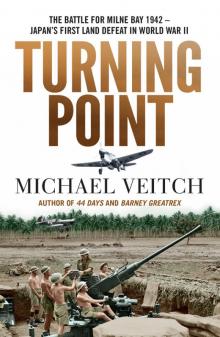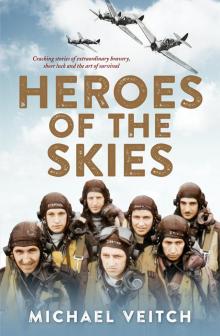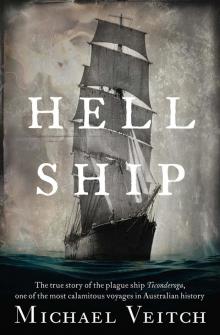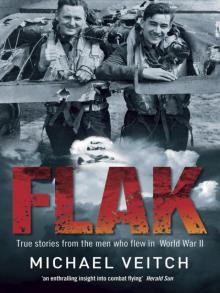- Home
- Michael Veitch
Turning Point Page 9
Turning Point Read online
Page 9
The boys’ four-year course was cut short by the coming of the war, and Norman and Cyril both found themselves as young lieutenants landing at Gallipoli on the very first ‘ANZAC Day’, 25 April 1915. As a forward observation officer with the 1st Field Artillery Brigade, Cyril was directing gunfire onto Turkish positions; he was wounded by a returning shell, rendering him partially deaf for the rest of his life. Norman was also wounded at Gallipoli. Both recovered and went on to serve on the Western Front, where their careers progressed uncannily in step. They served for long periods under fire at some of the war’s bloodiest battles, such as the carnage of Pozières, which claimed the lives of over 2000 Australian soldiers for little discernible gain. By war’s end, both brothers had each picked up a Distinguished Service Order and Military Cross, and had risen to the rank of major. Their reputations were of competence, combined with an utter disregard for their own safety.
After the war, Norman transferred to the British Army, where he rose to the rank of major general, seeing action in the Western Desert and becoming a member of General Harold Alexander’s staff, and aide de camp to King George VI. Cyril, meanwhile, returned to his former college of Duntroon as an instructor, before seeing further action in the doomed Greek campaign of 1941, where he proved himself a superb artilleryman.
Because of his calmness, organisational skills and ability to quickly assess complex situations, General Blamey sent Cyril Clowes in to command a New Zealand battalion which was in danger of collapsing in the face of a German advance, which would have threatened the entire Anzac left flank and compromised its southern withdrawal. Clowes calmly explained the situation to the men, informing them that they must maintain their position, ‘even in the face of extinction’, and remained with them to share their fate if required. The men held, and a rout was avoided.
Clowes was brought back to Australia in January 1942 to face another crisis as the Japanese swept towards his homeland. Rated highly by the commander-in-chief of the Australian military forces, General Blamey, Clowes was considered just the sort of officer to put some steel into the leadership at home. Initially given command of the army’s 1st Division, protecting the Sydney–Newcastle area, Clowes was deemed by Blamey as the right man to take command of the newly formed Milne Force and repel the expected Japanese invasion in that area.
Despite this record, no biography of Cyril Clowes’ life has ever been written. His face has never appeared on a stamp. Even among the historically literate, his name is largely unknown. His reward for delivering the beleaguered Australian forces their first ever victory against the Japanese at a desperate period of the war, when such a feat was barely considered possible, is to have been erased completely from the consciousness of those he so valiantly served, the Australian people.
To be fair, this process was underway even as the battle of Milne Bay raged about him, and the brightness of his star in the eyes of Blamey and MacArthur began to fade. After the victory, he was not considered for any larger or even commensurate appointment; despite being made a Commander of the British Empire, he was given charge of the relatively obscure Victorian Lines of Communication Area for the remainder of the Second World War. This insult he accepted in good grace, and with his characteristic silence.
Clowes’ immediate colleagues, however, provided a more sanguine assessment. According to his chief staff officer, Colonel Fred Chilton, Clowes was ‘a fine commander and a steady man … a cautious man’.
Indeed, caution and unflappability – the very qualities which had elevated him to command Milne Force in the first instance – seem to have been his undoing. As a commander, Clowes never rushed, nor did he allow himself to be rushed into a decision. But when that decision had been made, he was unwavering in its execution – even when, as at Milne Bay, the fruits of the decision were not immediately evident. In the First World War, Clowes had seen the results of poorly planned and badly executed operations, with soldiers uncertain as to their objectives and responsibilities mowed down in their thousands in foreign fields. He was determined never to be that shade of commander, and never to spend the lives of his men so cheaply.
His long-time friend, fellow soldier and ultimate superior officer, Sir Sydney Rowell, said of him:
Cyril Clowes … was the most experienced and skilled gunner in the Australian Army. He had earned a reputation in World War One for being oblivious to personal danger, and he demonstrated his courage again in World War Two. But his fame rests not on his technical attainments but his command in a crisis.
Above all, Clowes was renowned for being a man of few words, or at least a man of few unnecessary words; he regarded the imparting of superfluous information as having the potential to lead to obfuscation. In a very public war in which publicity, for the first time, played a major part, this may have worked against him, as Fred Chilton added:
The only thing I think he can be criticised for is his lack of public relations – for not sending back phoney reports about what a wonderful job he was doing and how many Japs they’d killed and all this sort of thing. His reports were confined to purely military operations and he didn’t give the boys back in Melbourne what they wanted. At that stage most of them didn’t have a clue about fighting battles anyway.
Even to the men who knew and loved him, Clowes was not demonstrably communicative. At Milne Bay, he remained immaculate in his uniform, but did not force his men to be so. With the pipe that never seemed to leave his mouth, he studied the terrain of the bay, assessed his resources and made his decisions accordingly, ensuring that every man under his command knew his role exactly.
In fact, Clowes very nearly failed to take up his command of Milne Force. Receiving his orders in early August, he arrived at Port Moresby with a small number of staff officers, including one of Australia’s greatest doctor-soldiers, Lieutenant Colonel George Maitland, recently appointed as assistant director of medical services for Milne Force, who had served alongside Clowes with distinction in the Middle East. Nothing he had seen in the desert, however, would prepare him for Papua.
Also in the entourage was Clowes’ chief staff officer, Colonel Fred Chilton, who had already had a most exciting war in command of the 2/2nd Battalion in Africa and Greece. There, cut off in a gorge behind the German lines, he narrowly escaped capture by island-hopping across the Aegean to Turkey, hiding in barns and under the nets of friendly fishermen. Later in life, he would become one of the fathers of Australian intelligence, founding the Defence Signals Directorate.
Touching down in Port Moresby on 13 August, the staff wasted no time in transferring to another aircraft for the short flight to Milne Bay. As usual, the weather was appalling, and became progressively worse the closer they got to their destination. Their young American flying crew looked uncertain from the beginning of the journey, but when the clouds set in soon after leaving Moresby, one of them ventured down from the cockpit. ‘Say,’ he enquired of the senior Australian officers, ‘any of you guys got a map?’
This, according to Chilton, when he recounted the story years later, reduced the small party to stunned silence. A ‘very general’ map of Papua and New Guinea was pulled out of someone’s briefcase and passed to the American, who seemed most grateful. A few minutes later, however, he returned.
‘Say,’ he began again, ‘you don’t happen to know if there are any mountains around these parts?’
This shook away any vestige of politeness. ‘Yes!’ exclaimed the uniformed chorus. ‘It’s all bloody mountains here, up to 12,000 feet!’
Suddenly pale, the airman quickly made his way back to the cockpit, at which point the aircraft ‘shot up almost vertically’ through a hole in the clouds.
Eventually they came down to the sea near Buna, having flown in entirely the wrong direction. Here, Clowes ‘spoke to them very firmly’, advising the pilot to stay low to the water and follow the coast around until they located the entrance to the bay. With its fuel tanks nearly dry, the aircraft arrived at Gurney Field, the passengers now very
late and very relieved.
Clowes wrote of the incident a few days later:
Yes we did get here safely in the end, largely by guess and by God though. Pouring rain, the landing strip covered with water, a ceiling of a hundred feet, a complete lack of knowledge of the country and no maps in possession of the pilot, all helped to add an interest to the trip … Majors-General may be two-a-penny but before taking to the air with these people in the future, I recommend prior enquiry to ensure a reasonable degree of safety.
Chilton was far from impressed by what he saw at Milne Bay, and somewhat irked that their arrival seemed to take Brigadier Field’s staff by surprise. ‘When we first got there, we had nowhere to go,’ he said. ‘We spent the first several days at Field’s headquarters.’ Clowes did not like the idea of making himself and his staff a target by occupying one of the few obviously European-built houses in the area, and so ordered the construction of inconspicuous Papuan huts, specially fitted out and established his new HQ further west at Hagita.
The first task of Clowes and his staff was to conduct a complete inspection of the camp, guided by Field, whose time as garrison commander was coming to an end. At this stage, despite being months away from the wet season, the rain beggared belief. Lieutenant Colonel Maitland was particularly alarmed. No facilities were initially available for his medical HQ, and he was forced to borrow an office to bring some order to the struggling medical units. Malaria, he saw immediately, was rife, with 92 men already under treatment. In fact, it was on the very day of his arrival that Milne Bay experienced its first casualty, which came not from an enemy action but from malaria, claiming the life of a young private named Neill from the 61st Battalion. The grave in which he was buried was a bare 18-inches deep, such was the paucity of the soil covering the limestone shelf.
The men’s personal and anti-malarial hygiene, observed Maitland, was appalling. Latrines were waterlogged, overflowing and badly sited, and even slit trenches were invariably filled with water, providing yet more breeding grounds for mosquitoes.
Transport, too, was an enormous problem, with almost all of the Australian two-wheel drive vehicles spending more time being pulled from bogs than driving. Not even the Bren gun carriers, which moved on continuous tracks rather than wheels, could easily negotiate the muddy roads. This made unloading stores from the now regular stream of ships pulling up to Gili Gili’s makeshift wharf slow, difficult and extremely labour-intensive.
What was being delivered continued to baffle the garrison’s officers and men alike. Someone at Townsville had thought fit to include on the inventory several cricket sets – complete with gloves and pads – for the troops’ entertainment, as if anything even faintly resembling a pitch could be found, not to mention the time to play. At one stage, discipline was tested when several ships arrived with large stocks of beer in their holds, having presumably taken the place of what was most required: bombs and ammunition. After several raucous incidents during which hundreds of empty beer bottles could be seen floating around the calm waters of the Gili Gili dock, a directive was issued to all officers: failure to severely discipline men for such behaviour would be seen as dereliction of duty. The consumption of beer was thereafter outlawed.
•
The Japanese were aghast at what they had stumbled upon at Milne Bay in early August. Their timetable for the conquest of South-East Asia was short, and no Allied base was still supposed to be operating. It was bad enough that Port Moresby remained unconquered, and now there appeared to be another enemy strongpoint. To make matters worse, the Milne Bay garrison had apparently been built right under their noses. Its existence represented an unacceptable threat to any future capture of Moresby by sea, as well as to the overland assault that was already underway from the north. The Japanese command determined, however, to make a virtue out of necessity. Rather than being a target, Milne Bay would become a prize.
The existing plans to capture tiny Samarai Island and use it as a staging point for an assault on Port Moresby were ditched, and a larger operation to storm and capture the airfield in the jungle prepared. It could then be used by Japanese aircraft.
An air assault against the Australians would begin imminently.
CHAPTER 12
JAPANESE PLANS
In the early morning of 8 August, the Japanese 25th Air Flotilla’s airfield at Rabaul throbbed to the sound of eighteen Zero fighters warming up for their flight almost due south to attack the Australian and American base at Milne Bay. The armed reconnaissance trip made on 4 August had given the Japanese pilots the lay of the land, and now the process of capturing this readymade base would begin.
The 25th Air Flotilla incorporated some highly impressive units, regarded as among the best in the Imperial Japanese Navy’s air wing. Foremost among them was the legendary Tainan Kokutai, which included some of Japan’s most glamorous aces, men such as Saburo Sakai, Enji Kakimoto and Hiroyoshi Nishizawa. Between them, these pilots were credited with a swathe of Allied victories. They were anxious to get into the air this morning to begin the attack on this brazen enemy, who had somehow built an airstrip in the backyard of Japan’s newly conquered Pacific territory. After air strikes, the navy and army would launch its assault, land along that long dismal shore and overrun the Allied defences. Today was just the beginning.
Saburo Sakai looked around at his fellow airmen, all the while keeping an eye on his instrument panel, waiting for his oil temperature gauge to rise sufficiently before he and his comrades would line up, open to full throttle and take to the air. Sakai was still awed by the wonderful Zero and what a delight it was to fly: its speed, its turning qualities and its amazing ability to climb, bolting to the higher altitudes like a feather on an updraught.
Warming up on the other side of the airstrip were 32 Betty bombers. Sakai and his fellow Zero pilots would escort them to Rabi (as they referred to the Milne Bay area, believing this village to be the site of the Allied garrison), let them do their work, then go in low to strafe the airfield as a prelude to invasion. It promised to be another glorious day.
Suddenly, he spotted one of the ground crew running towards his aircraft and waving frantically, signalling to Sakai and the others to cut their engines. Astonished, they complied and rolled back their canopies as their props came to a halt. Silence descended upon the airfield.
‘The patrol is cancelled,’ shouted a breathless ground crew member. ‘Please head to the briefing room immediately.’ In their flying kit, which suddenly felt dreadfully hot and awkward on the ground, the bewildered pilots trundled in.
In the crew room, none could guess what lay behind the turn of events. After a few minutes, their CO, Lieutenant Commander Tadashi Nakajima, walked in wearing the gravest look any of them could remember seeing. The young pilots stood rigidly to attention.
‘At 0525 hours this morning,’ Nakajima began, ‘a powerful enemy invasion force under heavy cover attacked Lunga Roads, Guadalcanal Island. The situation is extremely serious. Our naval forces operating in the Rabaul area have been ordered to engage the enemy immediately, in full strength, and to drive back the American invasion forces at any cost. Our fighter units are to escort the land-based medium-attack bombers, which will attack the enemy ships.’
The pall of silence in the room remained. Guadalcanal? No-one had heard of the place.
Nakajima’s next words induced more alarm: ‘We will take off at once for Guadalcanal to attack the enemy forces both at sea and on the beach.’
The battle for Guadalcanal, in the Solomon Islands, one of the epic campaigns of the Second World War, had begun.
For once, the Australians at Milne Bay had cause to be grateful for the amazing flying characteristics of the Mitsubishi Zero. A lesser aircraft could not have even been considered to cover the extraordinary distance from Rabaul to Guadalcanal, then attack the American marines disembarking on the north coast of the small island – and then fly back again.
The Americans’ aim at Guadalcanal oddly mirrored tha
t of the Japanese at Milne Bay: to capture an enemy airfield and turn it to their own use. Although the Guadalcanal strip was still incomplete, the American senior command said that, should the Japanese be allowed to make it operational, it would provide them with a base from which to threaten more of the Solomons, as well as Fiji and eventually places as far afield as New Caledonia.
Maps were rolled out over tables in the operations room and protractors used to determine that the Zeros would need to fly a round trip of more than 1100 miles to Guadalcanal, which was towards the south of the Solomons chain, and back. And this barely took into account time spent over the combat area, and the possibility of extra fuel consumption in case of stormy weather.
Nakajima informed his pilots that they were about to undertake the longest fighter operation in aviation history. Absolute discipline must be adhered to in order to conserve fuel. Sakai had shown that it could be done by making the mixture as lean as possible and flying high, and they were to do the same. In the worst instance, those running low might be able to refuel at Buka Island, north of Bougainville Island, 180 miles out from the base.
For the next hour, the men, barely believing what was being asked of them, sweated over maps, studied routes, and checked and double-checked their calculations. Drop tanks were filled and attached to the bellies of their aircraft. On the other side of the airstrip, the Betty bombers’ tanks were also topped up for a much longer trip – not south to Milne Bay, but southeast to Guadalcanal.
Everyone now looked skyward, expecting the Allies to launch a pre-emptive strike on the Rabaul base in support of their attack on Guadalcanal. No-one wanted to be caught on the airstrip. The bomber crews were also hurriedly briefed. There was not even time to reload with armour-piercing bombs or torpedoes to attack the American ships; they would proceed with the fragmentation bombs they had already stowed, despite these being of doubtful effect on shipping.

 Turning Point
Turning Point Heroes of the Skies
Heroes of the Skies The Forgotten Islands
The Forgotten Islands Hell Ship
Hell Ship Flak
Flak Fly
Fly